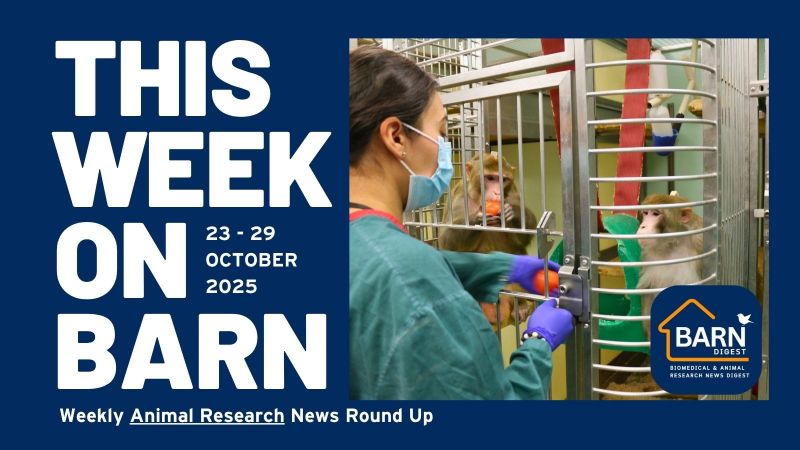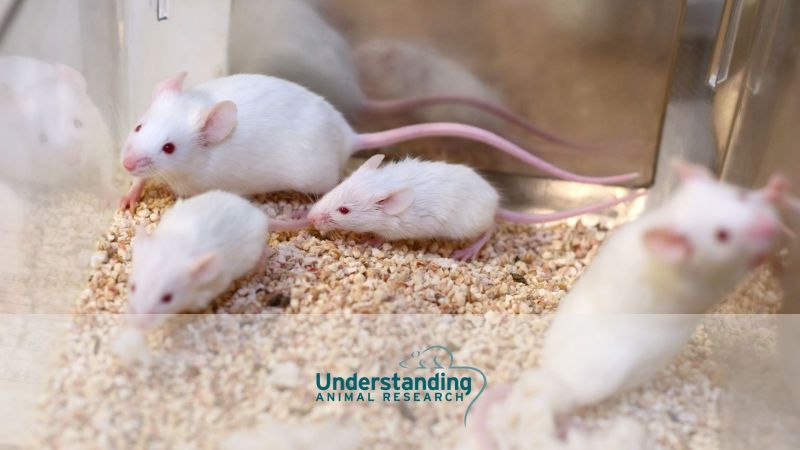Myths and facts about animal testing
A number of common misconceptions and myths continue to surround the use of animals in scientific research. On this page we cover common questions including; are animals used to test cosmetic products? Can we really replace animal tests easily? And is animal research actually leading to treatments for people?
MYTH: Animals are used to test cosmetic products
FACT: Cosmetic testing on animals was banned in 1998, UK
Animals are not used to test cosmetic products or their ingredients in the United Kingdom or across the EU. The sale and import of cosmetic products and their ingredients was banned in the UK in 1998. The UK was the first country in the world to introduce a ban on animal testing for cosmetic purposes.
The EU followed in 2012, implementing the EU Regulation 1223/2009 which put an end to the sale and export of cosmetic ingredients in EU territories.
Associated Links:
MYTH: Research on animals is not relevant to people because animals are different from people
FACT: The similarities and differences are well-known, and both are useful in different ways
All mammals are descended from common ancestors, so humans are biologically very similar to other mammals. All mammals, including humans, have the same organs – heart, lungs, kidneys, liver etc – that work in the same way, controlled via the bloodstream and nervous system.
All mammals, including humans, have the same organs – heart, lungs, kidneys, liver etc – that work in the same way, controlled via the bloodstream and nervous system.
Of course there are differences, but these are far outweighed by the similarities. The differences can also give important clues about diseases and how they might be treated – for example, if we knew why a mouse with muscular dystrophy suffers less muscle wasting than human patients, this might lead to a treatment for this debilitating and fatal disorder.
Many of the most important discoveries about human biology have ben made possible because of the similarities between human and animal physiology. Vitamins, for example work in the same way in animals as they do in people – research on guinea pigs led to the discovery of how vitamin C works. Hormones found in animals also work in a similar way in people. The following animal hormones have all been used successfully in human patients: insulin from pigs or cows; thyrotropin from cows; calcitonin from salmon; adrenocorticotropic hormone from pigs, cows and sheep; oxytocin and vasopressin from pigs.
For more information on how research in specific animal species has contributed to medical science, see ‘Animal research species’.
Above: Humans Vs Mice: how our organ systems compare
Associated Links:
MYTH: Animals don’t need to be used in research because there are alternatives
FACT: Animals are only used in research when there is no alternative
By law, animals cannot be used in a research project if viable non-animal techniques are available, but we cannot yet reproduce complex diseases in a cell culture, get a computer to cough, or examine a whole beating heart in a test-tube.
Most research is already carried out using non-animal methods. But we still need to use animals at some point. The living body is much more than just a collection of its parts; we need to understand how they interact. Humans can only be used in limited situations.
Scientists have strong ethical, economic and legal obligations to use animals in research only when necessary. As science progresses, it may be possible to reduce further the numbers of animals used in some areas. In other areas, the numbers of animals may increase.
The guiding principles in animal research today are called the three Rs: Refinement, to make sure animals suffer as little as possible; Reduction, to minimise the number of animals used; Replacement, to replace animals with non-animal techniques wherever possible;
Associated Links:
MYTH: Thalidomide did not cause birth defects in animals
FACT: Thalidomide was not tested on pregnant animals and causes birth defects in many species of animal
Thalidomide, a drug which was prescribed to pregnant women for morning sickness, caused serious birth defects in many of their children. It is sometimes claimed that the notorious drug thalidomide did not cause birth defects in animals. The thalidomide tragedy has been cited as an example of animal tests failing to protect human patients, but this is incorrect.
The major factor missing from this revised version of history is that thalidomide was not tested on pregnant animals before it was prescribed to pregnant women.
It was only after birth defects became apparent in human babies that the appropriate tests were carried out on animals. When thalidomide was tested on pregnant animals, the same birth defects were caused in the animals’ offspring as those seen in humans.
The failure to test thalidomide on pregnant animals led directly to the introduction of the UK Medicines Act in 1968, and the introduction of mandatory safety testing in animals before human testing can begin.
“Two categorical statements can be made about thalidomide. First, thalidomide was never administered to pregnant animals before it was used in humans. Secondly, only five months after the teratogenic effects of thalidomide had been established and the drug withdrawn, embryopathic actions of thalidomide were shown to occur in rat and rabbit (1). Over the following ten years foetal malformations caused by thalidomide were demonstrated in seven other species of small mammal and eight species of monkey.” - Jack botting – animals and medicine
Associated Links:
MYTH: Animal research doesn’t work and hasn’t made any contribution to medical progress
FACT: Animal research was involved in the majority of medical advancements
Animal research has played a significant role in advancing the life sciences for at least 100 years. There are countless examples of studies in animals that contributed to major medical breakthroughs and discoveries about human and animal biology. 
The discovery of insulin in dogs in the 1920s by Banting and Best is a good example of a significant contribution of animal research to medical progress. Before the discovery of insulin, there was no effective treatment for diabetes and half of the people who developed the disease died within two years; more than 90% were dead within five years. Naturally, the discovery of insulin has also benefited animals that suffer from diabetes including dogs and cats.
Our understanding of most common diseases has been advanced or improved through animal research in modern history. Find out about the contribution of animal research to common diseases in research by disease.
Since the first Nobel Prize was awarded in 1901, the prizes have given public recognition to the world's greatest medical advances. According to Alfred Nobel's will of 1895, the Nobel Prizes are awarded to "those who, during the preceding year, have conferred the greatest benefit to humankind." Of the 114 Nobel Prizes that have been awarded for research into Physiology and Medicine, more than 80% have involved animal testing.
Given continued research using animals, we can expect further advances in the treatment of diseases such as Alzheimer’s disease, cancer, cystic fibrosis and crippling joint disease. It is very difficult to see how we could make such medical advances without animal research.
Four independent reports have found that animal studies make an important contribution to scientific and medical advances:
-
House of Lords Select Committee Report (2002)
-
Nuffield Council on Bioethics Report (2005)
-
Weatherall Report (2006)
-
Bateson Review (2011)
Associated Links:
MYTH: The clinical trial disaster (testing the medicine TGN1412) at Northwick Park shows that animal tests don't work
FACT: The expert inquiry found multiple issues with the design and methods used during the clinical (human) trial of TGN1412
TGN1412 is a monoclonal antibody, a kind of medicine that was very new in 2006 when it went into clinical trials at Northwick Park. None of the tests done before the clinical trial had predicted severe side-effects. The expert inquiry into what went wrong at the trial described the human blood cell tests performed before the testing in humans as a “striking failure”, and the clinical trial itself was found to be poorly designed. Testing the safety and effectiveness of monoclonal antibodies, can be more difficult than most medicines, but many monoclonal antibodies that have been developed in animals, including breast cancer treatment Herceptin, have saved hundreds of lives.
There are around 300 clinical trials every year in the UK, yet the kind of problem seen at Northwick Park Hospital is very rare, partly because animal and other tests are so good at discovering problems. To suggest that we abandon some tests because they are not 100% perfect is like saying that we should stop wearing seatbelts because they do not prevent all injuries in road accidents.
Associated Links:
MYTH: Vaccines are dangerous and do not work
FACT: Vaccines are responsible for eradicating some of the most deadly diseases
All vaccines available in the UK have been tested extensively on animals and humans before being made available to the public. Animal tests are used to ensure that human volunteers that take part in clinical trials will not suffer severe or fatal side effects. Animal tests, usually in monkeys, are also carried out to see if the potential vaccine is likely to elicit an immune response and therefore be effective. However, it is only after the results of tests in humans that researchers can truly decide if the vaccine is good enough to produce in large quantities and make publicly available. No one has died in a clinical trial of any vaccine in the UK and severe side effects are exceptionally rare.
Vaccines have changed human history forever, virtually eradicating some ‘old’ diseases like TB, diphtheria and cholera, particularly in developed countries. The once rampant childhood infections such as meningitis and MMR have been greatly reduced following wide spread vaccination programmes across the country. When vaccination is not taken up by a good majority the number of cases, of measles for instance, rises. Unfortunately, there have been reports in the last year or two of a rise in measles cases in the USA following an increase in vaccine scepticism.
The major triumph of vaccination is the complete eradication of smallpox worldwide. Smallpox was eradicated thanks largely to a worldwide vaccination programme. The World Health Organisation aims to eliminate polio worldwide by immunisation. It is worth noting that the last case of natural polio infection acquired in the UK was in 1984. Rabies has also been eradicated in the UK, with the last case of rabies acquired in the country in 1902.
Associated Links:
MYTH: Many pointless, unnecessary experiments are carried out on animals
FACT: Animal experiments must be justified and approved by multiple review boards and the government before being licensed
Unnecessary animal experiments are very unlikely in the UK for the following reasons:
- The strict controls on animal research, in the Animals (Scientific Procedures) Act 1986, do not allow animals to be used to obtain information that is obtainable by other means.
- Research using animals is very expensive because the animals are costly to buy or breed, to house, and to care for, and the work itself is slow and labour intensive.
- Funds for biomedical research are limited, so each research proposal is rigorously assessed by panels of experts. Trivial, irrelevant or repetitive work will not attract funding.
Associated Links:
MYTH: Most research animals are cats, dogs or monkeys
FACT: Over 97% of experimental procedures are carried out on mice, fish, rats and birds
Cats, dogs, and monkeys can only be used in scientific research if there is no other suitable species; they make up a very small percentage of the overall research carried out in animals.
The vast majority of animal testing occurs in mice, fish, rats, and birds. Together these species account for 96% of all animal research in the UK.
In total, cats, dogs, and monkeys make up 0.23% of the research carried out on animals in the UK.
Dogs, because of the size of their organs and their similarity to the human equivalents, are important for the development of new surgical techniques and for the study of the heart, lungs and blood vessels. Cats have been important in the study of hearing and brain function. The use of both cats and dogs is subject to particular controls which require that they are specially bred for research. Stray cats and dogs or lost pets are never used for research in the UK.
Similarly, monkeys are used sparingly and only when no other species is suitable for the research. Monkeys are used in less than 0.1% of studies with animals in the UK. Most monkey research is carried out with macaques and marmosets.
It is illegal to use the great apes, such as gorillas and chimpanzees, in scientific research in the UK.
For the latest statistics on animal research in Great Britain see “Animal research statistics”.
Associated Links:
- Animal research species
- Medical advances timeline
- Dog testing FAQ
- Monkeys in medical research
- Animal research statistics
MYTHS: The laws and regulations protecting laboratory animals are weak
FACT: The UK maintains the strictest regulations on animal testing in the world
Around the world, the welfare of animals in research is protected by national and international legislation, by local laws and by ethical committees. The UK is widely recognised as having some of the most comprehensive and effective regulations covering laboratory animal welfare.
Scientists in the UK must comply with strict national regulations and also submit their research proposals to a local ethical review, known as an Animal Welfare and Ethical Review Body (AWERB).
In the UK, animal research and testing is regulated under the Animals (Scientific Procedures) Act 1986.
To put this into context, if food were regulated like experiments, you would need ethical approval and a licence from the Home Office to eat a chicken sandwich!
Associated Links:
MYTH: Researchers do not care about the well-being of laboratory animals
FACT: Animal welfare is essential to good, reproducible results in scientific research
Researchers are concerned about the welfare of the animals that they study and this concern is both humane and scientific. Scientists are at least as caring as other people and, like anyone else, often have pets of their own. They have no reason to mistreat research animals and good reasons for treating them well, because the use of unhealthy, stressed or frightened animals would reduce the reliability of an experiment’s results. Researchers are supported by specially trained and credentialed animal technologists who make sure that their animals are well fed, well housed and kept free of infections and other illnesses.
Associated Links:
MYTH: Laboratory animals suffer great pain and distress
FACT: More than 40% of research does not cause any pain to lab animals
By law, researchers must work to minimise the suffering of animals in laboratories. This might be by using anaesthetic or pain-killers to alleviate pain during or after a procedure, or it could be providing enrichment in the animals’ housing to encourage mental stimulation and prevent boredom.
More than 40% of all animal testing is classified as sub-threshold, meaning that it does not cause any pain to the animal. Roughly 36% is classified as mild, which means it involves pain that is no worse than that of an injection with a hypodermic needle. Less than 3% of research using animals is classified as causing severe pain or distress. For the latest statistics on the severity of experiments on animals see “animal research statistics”.
It is in researchers’ interests to make sure animals suffer as little as possible because stressed animals do not produce reliable, reproducible, results. All animal research must pass an ethical evaluation which weighs up its pros and cons and decides whether it is justified. The research then has to be approved by Home Office Inspectors, who are primarily doctors or vets who ensure that animal welfare is always a priority.
Laboratory animals are cared for by specially trained animal technicians who are required to complete extensive training and education. Animal technicians, and researchers, make sure that animals are well fed, housed appropriately, and are kept free of infections and other illnesses, unless it is a requirement of the research.
Each laboratory also has a veterinary surgeon available 24 hours a day and a Named Animal Care and Welfare Officer (NACWO) who has a legal and ethical responsibility to minimise suffering and optimise the welfare of animals in their care.
Associated Links:
MYTH: There is an endless list of drugs that have to be withdrawn because of side effects and these side effects are a major cause of hospital deaths
FACT: Fewer than 1% of drugs have ever been withdrawn. Animal tests work very well to prevent highly toxic or lethal drugs from entering clinical trials in humans
Only around 4 in every 100 medicines are withdrawn after their launch because of side effects which were undetected during both human and animal tests. Of the 2,000 types of medicine on the market, since 1961 only about 40 have been withdrawn in the UK, US, France or Germany due to serious side effects. This indicates a success rate of at least 98% for medicines testing. Only 10 of the 40 medicines withdrawn have been withdrawn in all four countries.
Numbers of drug induced deaths or hospitalisation due to side effects are often exaggerated or misleading. Most of these deaths are not caused by normal doses of drugs, but are in fact due to accidental or deliberate overdose.
Associated Links:
UAR Fact Checking series
Check out our newest fact checking video series where we ask the public "true or false?" regarding some common myths and misconceptions around animal research.
Visit our YouTube channel to watch the whole series.



